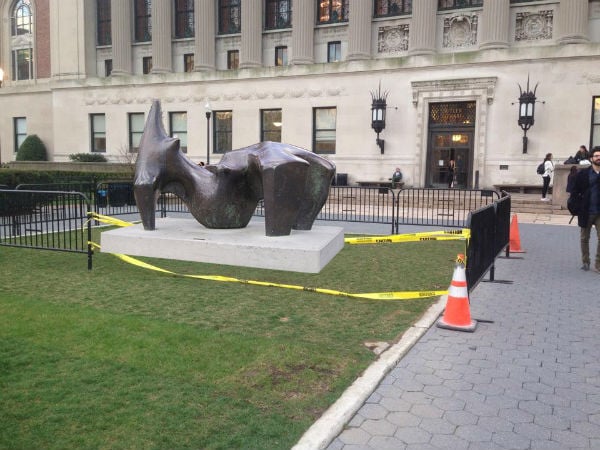
Henry Moore’s Reclining Figure.
Image: via Columbia’s New Public Sculpture Outdoor blog.
Columbia University is once again being rocked by protest. Students are standing up and making their voices heard in a righteous showdown with the most insidious foe of the present-day political landscape. I refer, of course, to abstract art.
Specifically, a vocal group of students is up in arms (on social media) about the planned installation of a sculpture by British artist Henry Moore, Reclining Figure. It is hard to think of a modern sculptor who is more pastoral and inoffensive than Moore, but evidently not everyone is buying what they are selling in “Modern Art 101.”
More than 1,000 students have signed a petition decrying the “hideous sculpture,” according to the Columbia Spectator. The petition asserts that “the sculpture in front of Butler Library will disrupt on [sic] an otherwise crisp, geometric, and symmetrical landscape.”
The horror of asymmetry comes to Columbia!
A “sit-in” is to take place tonight on the planned site of Reclining Figure. Some 200 have signed up to protest what a Facebook event invite calls Moore’s “ugly, grotesque statue.” Chris Bolton, one of the creators of the event, implores his peers, “PLEASE! PLEASE! PLEASE sign this petition to keep this gargantuan metal garbage heap off of our lawn.”
Illustration titled “Scale Composite of The Sculpture to be Installed” from the anti-Henry Moore petition.
Word of the new addition to the Columbia campus broke on Monday, but the backlash seems to have really taken off in the last 24 hours, which saw the Spectator publish an op-ed called “Statue of Limitations” that amped the anti-modernist rhetoric up to 11. The choicest bits:
The bronze monument, titled Reclining Figure, was sculpted by the noted English artist Henry Moore—presumably after he woke up from a terrible nightmare. As both inheritors and wards of our beautiful campus, we object to this desecration of our home. We also condemn the administration’s surreptitious launch of this offensive project.
It continues with a stirring defense of the virtues of neo-Classicism, and a Sesame Street reference:
We cannot ignore the fact that Reclining Figure will necessarily be compared to the dignified Alma Mater, our campus’s most significant statue. Sculptor Daniel Chester French, best known for the Lincoln Memorial, designed Alma Mater as an idealization of the University Seal. Reclining Figure is an idealization of a chewed wad of gum. Within view of Reclining Figure will also be the bronze casts of founding fathers Thomas Jefferson and Alexander Hamilton. One of these is not like the others.
Finally, the thunderous crescendo:
We recognize that Reclining Figure may already be a done deal. The foundation has been dug, the announcement made, albeit quietly. But as we write, Reclining Figure is not yet moored in front of our beloved Butler. We cling to some hope that it’s not too late—and that Alma Mater won’t have to stare at that ugly hunk of metal for the rest of goddamn time.
The piece is signed by three current students, Alex Randall, Daniel Stone, and Hallie Nell Swanson, as well as alumnus Jeremy Liss, who graduated in 2013.
Daniel Chester French, Alma Mater (1903-04) on the Columbia campus
Image: Wikimedia Commons
The placement of Reclining Figure outside of Butler Library was made public in an administration blog post. The donors of the piece are David and Laura Finn (David is co-founder of Ruder Finn, the art PR agency). That post stated, “The donation of this sculpture was accepted by the Committee on Art Properties and University administration over twenty years ago, with the permanent location approved more recently,” without specifying how that decision was made.
The campus backlash seems to be, on the one hand, stunningly conservative for a bastion of the liberal arts, and, on the other, precisely the kind of trivial grievance-mongering that has been so often used to discredit more valiant campus activism. It is worth noting, in passing, that the rather narrow artistic tastes of the petition’s authors are themselves mixed up with some bigger issues.
What seems to have rallied support to the anti-sculpture cause is the perceived high-handedness of the Columbia administration, which does not have a great track record of late in responding to student concerns. In this context, the unexpected addition of the Moore in a central area on a campus where green space is in short supply has made it vulnerable to becoming a symbol of institutional tone-deafness.
Not everyone, however, thinks this particular cause is the best one to defend: “If you are going to spend your time and energy protesting a piece of abstract art, why not also re-direct that focus towards serious and productive changes we need desperately on this campus,” reads a somewhat exasperated rival Facebook invite, which demands the administration instead sell the Moore to fund a 24-hour rape crisis center. It directs visitors to the demands of No Red Tape, an activist group that seeks to combat sexual assault on campus.